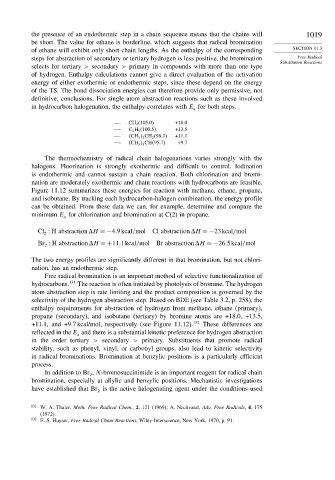Page 1035 - Advanced Organic Chemistry Part A - Structure and Mechanisms, 5th ed (2007) - Carey _ Sundberg
P. 1035
the presence of an endothermic step in a chain sequence means that the chains will 1019
be short. The value for ethane is borderline, which suggests that radical bromination
of ethane will exhibit only short chain lengths. As the enthalpy of the corresponding SECTION 11.3
steps for abstraction of secondary or tertiary hydrogen is less positive, the bromination Free Radical
Substitution Reactions
selects for tertiary > secondary > primary in compounds with more than one type
of hydrogen. Enthalpy calculations cannot give a direct evaluation of the activation
energy of either exothermic or endothermic steps, since these depend on the energy
of the TS. The bond dissociation energies can therefore provide only permissive, not
definitive, conclusions. For single atom abstraction reactions such as these involved
in hydrocarbon halogenation, the enthalpy correlates with E for both steps.
a
—- CH 4 (105.0) +18.0
—- C 2 H 5 (100.5) +13.5
—- CH
2 CH 2 (98.1) +11.1
3
—- CH
3 CH 95 7
+9.7
3
The thermochemistry of radical chain halogenations varies strongly with the
halogens. Fluorination is strongly exothermic and difficult to control. Iodination
is endothermic and cannot sustain a chain reaction. Both chlorination and bromi-
nation are moderately exothermic and chain reactions with hydrocarbons are feasible.
Figure 11.12 summarizes these energies for reaction with methane, ethane, propane,
and isobutane. By tracking each hydrocarbon-halogen combination, the energy profile
can be obtained. From these data we can, for example, determine and compare the
minimum E for chlorination and bromination at C(2) in propane.
a
Cl H abstraction H =−4 9kcal/mol Cl abstraction H =−23kcal/mol
2
Br H abstraction H =+11 1kcal/mol Br abstraction H =−26 5kcal/mol
2
The two energy profiles are significantly different in that bromination, but not chlori-
nation, has an endothermic step.
Free radical bromination is an important method of selective functionalization of
hydrocarbons. 131 The reaction is often initiated by photolysis of bromine. The hydrogen
atom abstraction step is rate limiting and the product composition is governed by the
selectivity of the hydrogen abstraction step. Based on BDE (see Table 3.2, p. 258), the
enthalpy requirements for abstraction of hydrogen from methane, ethane (primary),
propane (secondary), and isobutane (tertiary) by bromine atoms are +18.0, +13.5,
+11.1, and +9.7 kcal/mol, respectively (see Figure 11.12). 132 These differences are
reflected in the E and there is a substantial kinetic preference for hydrogen abstraction
a
in the order tertiary > secondary > primary. Substituents that promote radical
stability, such as phenyl, vinyl, or carbonyl groups, also lead to kinetic selectivity
in radical brominations. Bromination at benzylic positions is a particularly efficient
process.
In addition to Br , N-bromosuccinimide is an important reagent for radical chain
2
bromination, especially at allylic and benzylic positions. Mechanistic investigations
have established that Br is the active halogenating agent under the conditions used
2
131 W. A. Thaler, Meth. Free Radical Chem., 2, 121 (1969); A. Nechvatal, Adv. Free Radicals, 4, 175
(1972).
132
E. S. Huyser, Free Radical Chain Reactions, Wiley-Interscience, New York, 1970, p. 91.

